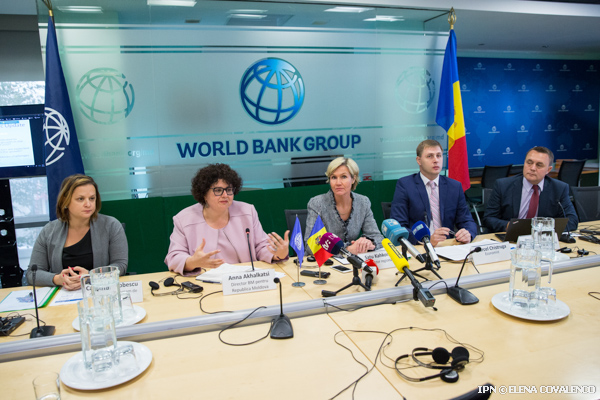
The World Bank anticipates that Moldova’s economy will grow by 3.5 percent in 2017, driven by strong private consumption and a good harvest. Strengthening growth in the medium-term will depend on the restructuring of the financial and energy sector and efficiency of public finances. The conclusions were formulated in an event held to present the economic outlook for Moldova on October 2, IPN reports.
Economist Marcel Chistruga said that in the first half of 2017, real GDP increased by 2.8 percent mainly driven by private consumption. The recovery in remittances, strong growth in wages and the indexation of pensions in 2016 drove consumption growth (+3.6%, y/y). Despite robust exports (+14.6%, y/y), supported by the good harvest of 2016 and a weaker Leu, imports increased 13.9%, resulting in a negative contribution from net exports to growth. Fixed investment rebounded from its sharp decline in 2016, and grew 4.8%, y/y. The build-up in inventories added another 2.3 percentage points to overall growth. On the production side, with stagnating industry, the main growth impulse came from retail and wholesale trade, while agriculture contracted in the first half of 2017 by 4.1%, y/y.
Thanks to the reinvested incomes, the net direct investments rose to 2.2% of the GDP, from 1.6% at the end of 2016. After the decline of 2016, remittances grew by 10.5%. The external debt remained the main source of financing the current account deficit. Owing to the appreciation of the leu, the external debt decreased by 5.7 percentage points to almost 92% of the GDP.
According to Marcel Chistruga, the current account deficit increased to 9.3 percent of GDP from 5.9 percent a year earlier driven by stronger imports growth than export performance. On account of reinvested revenues, net direct investments reached 2.2% of GDP, from 1.6% at end-2016. After decline in 2016, remittances increased 10.5%. External debt remained the main source of current account deficit financing. Due to Leu appreciation, external debt decreased by 0.6 percentage points to almost 92 percent of GDP.
The economy is expected to grow 3.5 percent during 2017, supported by good harvest and strong private consumption on the back of higher remittances and private and public wage growth. Despite favorable exports developments, the contribution of net trade to GDP growth is likely to remain negative as imports are rapidly expanding. In 2017, with lower external assistance from the EU, the fiscal deficit is forecasted to remain below the planned 3 percent of GDP.
Strong revenue performance is expected to offset higher public spending. Should additional international support materialize, public investments will increase further. The revitalization of foreign inflows, and improvements in the financial sector and in the business environment are expected to encourage further private investments.
Marcel Chistruga also said that key downside risks to the baseline outlook include a slowdown in the implementation of key growth-enhancing reforms, including those related to the restructuring of the financial and energy sector and to the efficiency of public finances.
World Bank Country Manager for Moldova Anna Akhalkatsi said the economic outlooks are an important component of the WB’s activity and these are made once in six months. “This is an opportunity for us to analyze the state of economy, the economic tendencies and to make particular medium-term forecasts. It is important for our program and our political dialogue with the Government. We also offer this document to the development partners and the mass media so that the tendencies are known and measures are taken in this regard,” stated Anna Akhalkatsi.
World Bank Group Country Director for Belarus, Moldova and Ukraine Satu Kahkonen said the only possibility to increase the level of incomes in Moldova is to continue the decisive reforms, despite the fact that next year will be an electoral one.


